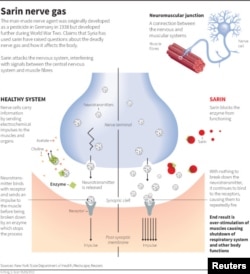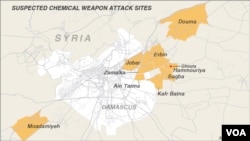WASHINGTON —
The World Health Organization has released new interim guidelines for health care workers treating patients who may have been exposed to chemical weapons.
The document includes questions to help doctors determine what agent may have been used and outlines how patients should be decontaminated and treated. The document is does not specifically name Syria or refer to particular agents—but WHO admits that it “rushed” to publish the guidelines in response to reports that chemical weapons -- in particular nerve agents -- have been used in Syria.
What chemical weapons does Syria possess?
It is believed that Syria is able to develop and produce the blistering agent, mustard gas, as well as the nerve gas sarin--and possibly also VX nerve agent. Nerve agents are called that because they attack the human nervous system.
Medecins Sans Frontieres (MSF) says it has received credible reports from Syrian doctors who say that on August 21, they received approximately 3,600 patients showing “neurotoxic” symptoms—that is, signs that poison had affected the person’s nervous system. Three hundred fifty-five of those patients reportedly died.
MSF says it cannot confirm the cause of the symptoms. However, experts now believe the likely cause was the deadly neurotoxin sarin.
Sarin
Sarin is a clear, colorless and tasteless liquid that has no odor. It can evaporate into a gas and spread into the environment. Because it evaporates quickly, the threat is immediate — but not long-lived.
How sick a person becomes after being exposed to sarin depends on how much he or she is exposed to, how long and how the gas is delivered. Symptoms usually appear within a few seconds of exposure to sarin vapor and a few minutes to 18 hours after exposure to liquid sarin.
Symptoms may include: “pinpoint” pupils and blurred vision; difficulty breathing; muscle twitching; excess saliva and other secretions; impaired judgment, seizures and unconsciousness.
Treatment
If doctors determine that someone has been exposed to nerve agents, they first decontaminate the patient, cleaning the skin of any dry debris or powder, then rinse and wash the affected areas thoroughly, making sure that any waste or water used during the process is contained, so as to avoid further contamination.
Only after the patient is decontaminated do doctors begin treatment, usually injections of Atropine.
Long-term effects
Exposure to large doses of sarin can cause death.
People who have been exposed to small levels of sarin usually recover completely, but fatigue, irritability, nervousness and memory problems could last for weeks.
Some studies have suggested that severe sarin poisoning can cause long-term central nervous system symptoms, such as changes in brain activity. Fatigue, irritability, nervousness and memory problems may last up to six weeks after recovery from exposure to sarin.
Sarin’s impact on fertility is not known. Researchers say it is not likely to cause cancer.
The document includes questions to help doctors determine what agent may have been used and outlines how patients should be decontaminated and treated. The document is does not specifically name Syria or refer to particular agents—but WHO admits that it “rushed” to publish the guidelines in response to reports that chemical weapons -- in particular nerve agents -- have been used in Syria.
What chemical weapons does Syria possess?
It is believed that Syria is able to develop and produce the blistering agent, mustard gas, as well as the nerve gas sarin--and possibly also VX nerve agent. Nerve agents are called that because they attack the human nervous system.
Medecins Sans Frontieres (MSF) says it has received credible reports from Syrian doctors who say that on August 21, they received approximately 3,600 patients showing “neurotoxic” symptoms—that is, signs that poison had affected the person’s nervous system. Three hundred fifty-five of those patients reportedly died.
MSF says it cannot confirm the cause of the symptoms. However, experts now believe the likely cause was the deadly neurotoxin sarin.
Sarin
Sarin is a clear, colorless and tasteless liquid that has no odor. It can evaporate into a gas and spread into the environment. Because it evaporates quickly, the threat is immediate — but not long-lived.
How sick a person becomes after being exposed to sarin depends on how much he or she is exposed to, how long and how the gas is delivered. Symptoms usually appear within a few seconds of exposure to sarin vapor and a few minutes to 18 hours after exposure to liquid sarin.
Symptoms may include: “pinpoint” pupils and blurred vision; difficulty breathing; muscle twitching; excess saliva and other secretions; impaired judgment, seizures and unconsciousness.
Treatment
If doctors determine that someone has been exposed to nerve agents, they first decontaminate the patient, cleaning the skin of any dry debris or powder, then rinse and wash the affected areas thoroughly, making sure that any waste or water used during the process is contained, so as to avoid further contamination.
Only after the patient is decontaminated do doctors begin treatment, usually injections of Atropine.
Long-term effects
Exposure to large doses of sarin can cause death.
People who have been exposed to small levels of sarin usually recover completely, but fatigue, irritability, nervousness and memory problems could last for weeks.
Some studies have suggested that severe sarin poisoning can cause long-term central nervous system symptoms, such as changes in brain activity. Fatigue, irritability, nervousness and memory problems may last up to six weeks after recovery from exposure to sarin.
Sarin’s impact on fertility is not known. Researchers say it is not likely to cause cancer.










